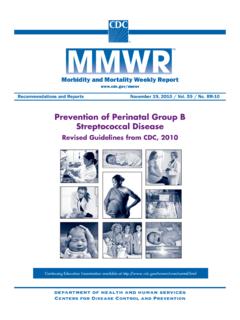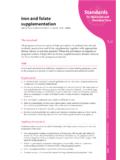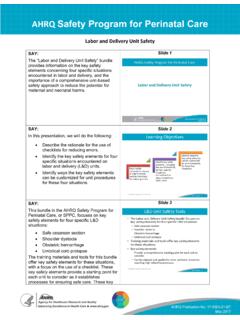Transcription of Birth Spacing and Birth Outcomes Key Points
1 Birth Spacing and Birth OutcomesBirth Spacing refers to the time from one child s Birth until the next pregnancy, also known as the interpregnancyinterval. Pregnancies that start less than 18 months after Birth are associated with delayed prenatal care and adverse Birth Outcomes , including preterm Birth , neonatal morbidity, and low ,2,3 Further, these poor Birth Outcomes are often associated with ongoing health problems such as developmental delay, asthma, and vision and hearing the United States, between 2006 and 2010, about 33% of pregnancies among women with a previous live Birth began less than 18 months after the prior Birth .
2 Placing mothers and infants at risk for adverse health Access to services that promote appropriate Birth Spacing can reduce the risk for poor Birth Outcomes such as preterm Birth and low March of Dimes promotes Birth Spacing interventions that are supported by scientific evidence and are most effective in improving maternal and child health Outcomes . The March of Dimes urges every woman to consult with a health care provider to select an approach to family planning and Birth Spacing consistent with her needs and beliefs. Family Planning Counseling Promotes Women s and Infants HealthPatient counseling and education prior to pregnancy are important for maternal and child health.
3 Family planning counseling includes well-woman care, preconception care, counseling about family planning services, and screening for HIV and intimate partner plays a key role in optimizing women s health prior to and during pregnancy to promote healthy pregnancies that are adequately For example, a network of Family Medicine residency programs found success in focusing on contraception counseling during pregnancy to promote adequate interpregnancy intervals and improve Birth Outcomes through the IMPLICIT (Interventions to Minimize Preterm & Low Birth Weight Infants through Continuous Improvement Techniques) quality improvement Points One in 10 babies is born preterm.
4 Pregnancies spaced less than 18 months after a live Birth are associated with delayed prenatal care and increased risk for adverse Birth Outcomes . Between 2006 and 2010, about 33% of all pregnancies among women with a prior live Birth in the occurred less than 18 months after the prior Birth . Appropriate Birth Spacing can reduce the risk for poor Birth Outcomes such as preterm Birth and low birthweight. Access to family planning counseling and contraception plays a key role in Birth Spacing and reduced risk for poor Birth Outcomes . Contact information: Nicole Garro at (202) sheetThe March of Dimes is a national voluntary health agency whose volunteers and staff work to improve the health of infants andchildrenby preventing Birth defects, premature Birth and infant mortality.
5 Founded in 1938, the March of Dimes funds programs of research,community services, education and advocacy. For the latest resources and information, visit Pregnancies Promote Adequate Birth SpacingAccess to contraception is associated with adequate Birth Spacing and reduced risk of adverse Birth Outcomes , including preterm Birth and low ,10,11In most cases, the Affordable Care Act requires health plans to cover all Food and Drug Administration-approved contraceptive methods prescribed by a woman s health care provider without categories of contraception include long-acting reversible contraception (or LARC, intrauterine devices, implants)
6 , hormonal methods (such as oral contraceptives), barrier methods (such as condoms or diaphragms) and natural family planning ( tracking ovulation). A comprehensive list of types of contraception and their relative effectiveness may be found here. States have found success in improving Birth Outcomes by promoting access to services to ensure appropriate Birth Spacing In Georgia, the Planning for Healthy Babies Program (P4HB), a Section 1115 Medicaid Demonstration Waiver, sought to reduce rates of low birthweight by providing family planning services to low income uninsured women, ages 18 through 44, who are not otherwise eligible for Medicaid or the Children s Health Insurance Program (CHIP).
7 P4HB also provides interconceptioncare to low income women who deliver very low birthweight infants (less than 1,500 grams or 3 pounds). By 2012, the program increased the use of highly effective methods and a modest decrease in the rate of low birthweight had taken place The Colorado Initiative to Reduce Unintended Pregnancy, funded by the Susan Thompson Buffett Foundation, aimed to reduce unplanned pregnancies by providing intrauterine devices and implants at no cost to consumers. LARC method use increased by 19%, and there was a decline of nearly 25% in statewide enrollment in the Supplemental Nutrition Program for Women Infants and Children (WIC).
8 14 Further, the teen Birth rate dropped by 40% and access to LARC and other family planning counseling was associated with a 12% decreased risk of preterm ,15 The state estimates that every dollar spent on this initiative saved $ for the state s Medicaid program due to improved Birth In California, Family PACT, a Medicaid family planning waiver, provides comprehensive family planning and preconception services to men and women at or below 200% of the federal poverty ,18 Elements of the program include preconception risk screening and provision of family planning counseling and contraception.
9 The program has succeeded in saving money and reducing unplanned pregnancy, and participants have higher odds for achieving optimal Birth 2011, California converted its family planning waiver to a State Plan Amendment to cover additional services for men and women including full coverage of family planning services and supplies as well as treatment of sexually transmitted South Carolina has a Medicaid State Plan Amendment which provides coverage of family planning services for both men and women at or below 199% of the federal poverty program has been successful at saving money, increasing use of contraceptive methods, and reducing rates of short Birth Between 1993 and 2005.
10 Continuity of contraceptive service use for over a year increased from 21% to 49%, and the proportion of participants with a subsequent pregnancy in less than 18 months decreased from 7% to 4%.17 The initiative is estimated to have saved the state more than $15 million annually by reducing unintended increased use of family planning services in South Carolina also improved access to adequate prenatal March of Dimes supports access to preconception and prenatal care, including Birth control counseling, education and services, to ensure proper Birth Spacing and reduce rates of preterm Birth and other adverse Birth Outcomes .










